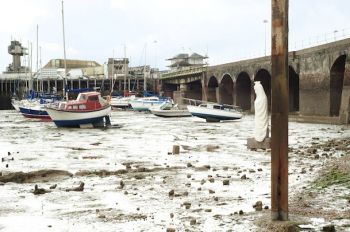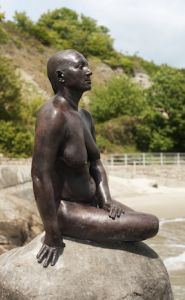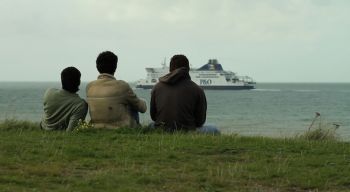theartsdesk in Folkestone: Art Echoes by the Seaside | reviews, news & interviews
theartsdesk in Folkestone: Art Echoes by the Seaside
theartsdesk in Folkestone: Art Echoes by the Seaside
18 artists' work decorates a seaside town with memories of better times
The locals are understandably proud of Folkestone; Everywhere Means Something to Someone is an idiosyncratic guidebook offering an insider’s view of the town that bears witness to the depth of people’s attachment to it. Put together for the Folkestone Triennial by the artists’ collective Strange Cargo, this compendium of facts, memories and musings makes for compulsive reading.
Ghosts feature large among the 250 snippets of information alongside memories of childhood games, frequently involving dens built from rubbish dumped in wasteland. For the visitor they bring the town to life. We learn about the house on the Bayle left to two sisters who then fell out and divided it in half, which explains the cheek-by-jowl front doors, and about a horse and cart that fell into one of the piers of the Foord railway viaduct while it was under construction in 1843; beyond rescue, the unfortunate animal had to be bricked into the structure. In WWII, Christchurch on Sandgate Road was bombed leaving only the tower standing; the railings surrounding the tower are hollow and on windy days, we discover, air reverberating in the tubes makes them sing.
A picture of car park signs by Ben Hills, who took all the photographs in this delightful little book, accompanies an entry about a message left on a classic burgundy-and-cream PA Cresta, asking if it was for sale. “That evening the owner popped round," we are told. “I fell in love with him instantly too! We have been married now for 17 years... and I never paid for the car!"
Many memories hark back to more prosperous days. We learn, for instance, that there was a Rolls Royce showroom on Sandgate Road at a time when, supposedly, there were more Rolls Royces in Folkestone than anywhere else. Huge hotels like the Metropole and gracious terraces like the Marine Crescent, whose Neo-Classical façade was cast from concrete mixed with shingle from the beach, attest to a time when Folkestone was an upmarket resort attracting royalty and celebrities with its pier, pleasure gardens, helter skelter, boating lake, swimming pool and zoo.
The pier burned down in 1945, but the Rotunda Amusement Park survived until 2003, when it was sold for redevelopment since package holidays had put paid to the local tourist industry. Hills’s photograph shows two bare feet standing on what remains of the open-air swimming pool – a small patch of concrete. “I clearly remember the rough texture of the concrete underfoot as I ran around the edge of the pool as a child,” recalls a resident. "It seemed to sting your feet. The pool was seawater and when you jumped in, an odd smell of cabbage water went right up your nose."
 Bristling with surveillance equipment, the concrete conning tower of the Pilot Station reminds you that Folkestone was once an important cross-channel port (pictured right, the harbour with sculpture by Tonico Lemos Auad), but the last ferry left for Boulogne 10 years ago and the harbour railway station, where the Orient Express used to stop on its way to France, is already derelict. The port’s final death knell came in 2000, when the high-speed hovercraft to Boulogne was axed. Nowadays the town feels as if it is holding its breath, waiting for the next phase. Most shops on the Old High Street are empty and stores in the pedestrian precinct have moved to the new shopping mall leaving the old town feeling scruffy and abandoned.
Bristling with surveillance equipment, the concrete conning tower of the Pilot Station reminds you that Folkestone was once an important cross-channel port (pictured right, the harbour with sculpture by Tonico Lemos Auad), but the last ferry left for Boulogne 10 years ago and the harbour railway station, where the Orient Express used to stop on its way to France, is already derelict. The port’s final death knell came in 2000, when the high-speed hovercraft to Boulogne was axed. Nowadays the town feels as if it is holding its breath, waiting for the next phase. Most shops on the Old High Street are empty and stores in the pedestrian precinct have moved to the new shopping mall leaving the old town feeling scruffy and abandoned.
Folkestone is pinning its hopes for regeneration on cultural initiatives. A new university specialising in the arts has been opened in a defunct glassworks refurbished by the Cultural Foundation, set up in 2002 to turn derelict buildings into shops, flats and studios, and the Folkestone Triennial is part of this process of reinvention. The first jamboree met with hostility from locals who resented their lack of involvement and the introduction of alien artworks, which is why this year’s Triennial has commissioned the alternative guidebook and encouraged artists to make work relevant to the town and the local community.
 Inspired by the Little Mermaid seated on a rock in Copenhagen Harbour, Cornelia Parker invited residents to come forward as potential models for a Folkestone equivalent. Georgina Baker was chosen and her bronze facsimile (pictured left) now watches over the waves from a rock above Sunny Sands. Based on the unhappy heroine of a fairytale by Hans Christian Andersen, her Copenhagen counterpart looks thoroughly forlorn, but Georgina displays earthy resilience as she exposes herself to the elements.
Inspired by the Little Mermaid seated on a rock in Copenhagen Harbour, Cornelia Parker invited residents to come forward as potential models for a Folkestone equivalent. Georgina Baker was chosen and her bronze facsimile (pictured left) now watches over the waves from a rock above Sunny Sands. Based on the unhappy heroine of a fairytale by Hans Christian Andersen, her Copenhagen counterpart looks thoroughly forlorn, but Georgina displays earthy resilience as she exposes herself to the elements.
All that remains of the amusement park is a stretch of tarmac resembling a disused airstrip. Suspended from steel poles high above this miserable spot, a single church bell sounds a melancholy note. When a new chime was installed in Scraptoft church, Leicestershire, this 16th-century bell was jettisoned for not having perfect pitch. Norwegian artist AK Dolven salvaged the bell and chose this desolate place for it to sound its discordant note – in memoriam, as it were, for the funfair, which was also deemed out of tune with the times.
The bell is aligned with the belfry of St Mary and St Eanswythe’s Church where Hew Locke has installed a colourful flotilla of model ships. Painted primary colours and decorated with flowers, 100 model boats – skiffs, junks, clippers, brigs, barges, trawlers and lifeboats – sail down the nave (itself shaped like an upturned boat) towards the altar. The boats in the harbour attest to the fact that Folkestone still has a fishing fleet, albeit on a modest scale, and Locke’s installation celebrates our ongoing relationship with the sea; but its title, For Those in Peril on the Sea, the last line of the Royal Navy Hymn, reminds one of the dangers of embarking in small craft and brings to mind the desperate migrants who attempt to reach foreign shores in overcrowded boats.
To get to the church from the foreshore one can take the hydraulically powered Leas Lift, which was recently saved from closure. Celebrating the fact that it continues to whisk passengers up and down the 164ft cliff, Martin Creed invited the Sacconi string quartet to play ascending and descending scales to echo the motion and enhance the trip.
 A series of Martello towers was built along this coast to guard against invasion by Napoleon’s fleet. Exploring the cliff top, Spanish artist Christina Iglesias came across a tower hidden beneath a morass of ivy and surrounded by an overgrown moat. Hacking a path through the vegetation, she created a platform to view the hidden relic (pictured right). This would have been enough, but to frame the view she also built a stainless steel corridor lined with casts of brambles, which is surplus to requirements.
A series of Martello towers was built along this coast to guard against invasion by Napoleon’s fleet. Exploring the cliff top, Spanish artist Christina Iglesias came across a tower hidden beneath a morass of ivy and surrounded by an overgrown moat. Hacking a path through the vegetation, she created a platform to view the hidden relic (pictured right). This would have been enough, but to frame the view she also built a stainless steel corridor lined with casts of brambles, which is surplus to requirements.
These works are all sympathetic to the town and its surroundings, yet the Triennial is titled A Million Miles From Home and includes foreign artists who are keen to emphasise their otherness. This apparent schizophrenia arises from the fact that, like many south-coast towns, Folkestone is home to large numbers of immigrants. The first session of the opening conference was titled Fear of Migrants and in a disused harbour café Danish artist Nikolaj Bendix Skyum Larsen is showing Promised Land (pictured below), a film about the young men who camp in Calais while planning to smuggle themselves into Britain, either by hiding in lorries or using false passports. Their determination is impressive and, despite lending the migrants a sympathetic ear, I doubt if this beautifully shot film will allay many people's anxieties.
 Other artists present snapshots of their own cultures. Erzen Shkololli has created a boutique filled with traditional costumes from Kosovo decorated with gorgeous embroidery. In another disused shop, Hala Elkoussy has created an archive exploring Cairo’s colonial past and unfolding present and, in a warren of darkened rooms, Smadar Dreyfus allows us to eavesdrop on Israeli children at their lessons. Both installations demand a lot from the viewer, which begs the question of whether the primary function of the Triennial is to interest the locals or boost Folkestone’s faltering economy by attracting visitors.
Other artists present snapshots of their own cultures. Erzen Shkololli has created a boutique filled with traditional costumes from Kosovo decorated with gorgeous embroidery. In another disused shop, Hala Elkoussy has created an archive exploring Cairo’s colonial past and unfolding present and, in a warren of darkened rooms, Smadar Dreyfus allows us to eavesdrop on Israeli children at their lessons. Both installations demand a lot from the viewer, which begs the question of whether the primary function of the Triennial is to interest the locals or boost Folkestone’s faltering economy by attracting visitors.
The answer, of course, is both and the winner in all this has to be the town. Featuring 18 artists, as yet the Triennial is not on a large enough scale to reward those who shlep down for the day, but the town is so fascinating that, armed with a copy of Everywhere Means Something to Someone, you could happily spend a weekend exploring its nooks and crannies while enjoying some interesting art en passant.
- The Folkestone Triennial continues until 25 September
The future of Arts Journalism
You can stop theartsdesk.com closing!
We urgently need financing to survive. Our fundraising drive has thus far raised £49,000 but we need to reach £100,000 or we will be forced to close. Please contribute here: https://gofund.me/c3f6033d
And if you can forward this information to anyone who might assist, we’d be grateful.

Subscribe to theartsdesk.com
Thank you for continuing to read our work on theartsdesk.com. For unlimited access to every article in its entirety, including our archive of more than 15,000 pieces, we're asking for £5 per month or £40 per year. We feel it's a very good deal, and hope you do too.
To take a subscription now simply click here.
And if you're looking for that extra gift for a friend or family member, why not treat them to a theartsdesk.com gift subscription?
more Visual arts
 'We are bowled over!' Thank you for your messages of love and support
Much-appreciated words of commendation from readers and the cultural community
'We are bowled over!' Thank you for your messages of love and support
Much-appreciated words of commendation from readers and the cultural community
 Abstract Erotic, Courtauld Gallery review - sculpture that is sensuous, funny and subversive
Testing the boundaries of good taste, and winning
Abstract Erotic, Courtauld Gallery review - sculpture that is sensuous, funny and subversive
Testing the boundaries of good taste, and winning
 Edward Burra, Tate Britain review - watercolour made mainstream
Social satire with a nasty bite
Edward Burra, Tate Britain review - watercolour made mainstream
Social satire with a nasty bite
 Ithell Colquhoun, Tate Britain review - revelations of a weird and wonderful world
Emanations from the unconscious
Ithell Colquhoun, Tate Britain review - revelations of a weird and wonderful world
Emanations from the unconscious
 Rachel Jones: Gated Canyons, Dulwich Picture Gallery review - teeth with a real bite
Mouths have never looked so good
Rachel Jones: Gated Canyons, Dulwich Picture Gallery review - teeth with a real bite
Mouths have never looked so good
 Yoshitomo Nara, Hayward Gallery review - sickeningly cute kids
How to make millions out of kitsch
Yoshitomo Nara, Hayward Gallery review - sickeningly cute kids
How to make millions out of kitsch
 Hamad Butt: Apprehensions, Whitechapel Gallery review - cool, calm and potentially lethal
The YBA who didn’t have time to become a household name
Hamad Butt: Apprehensions, Whitechapel Gallery review - cool, calm and potentially lethal
The YBA who didn’t have time to become a household name
 Bogancloch review - every frame a work of art
Living off grid might be the meaning of happiness
Bogancloch review - every frame a work of art
Living off grid might be the meaning of happiness
 Do Ho Suh: Walk the House, Tate Modern review - memories are made of this
Home sweet home preserved as exquisite replicas
Do Ho Suh: Walk the House, Tate Modern review - memories are made of this
Home sweet home preserved as exquisite replicas
 Ed Atkins, Tate Britain review - hiding behind computer generated doppelgängers
Emotions too raw to explore
Ed Atkins, Tate Britain review - hiding behind computer generated doppelgängers
Emotions too raw to explore
 Echoes: Stone Circles, Community and Heritage, Stonehenge Visitor Centre review - young photographers explore ancient resonances
The ancient monument opens its first exhibition of new photography
Echoes: Stone Circles, Community and Heritage, Stonehenge Visitor Centre review - young photographers explore ancient resonances
The ancient monument opens its first exhibition of new photography

Comments
...